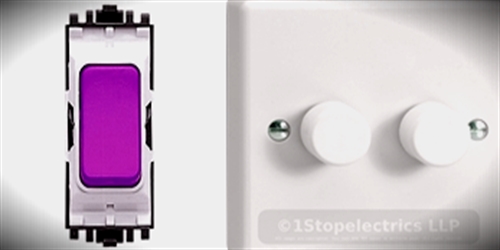Difference between One Way electrical Switches and Two way electrical Switches

In the tunnel of electrical technology, there are many other topics to discuss, but starting from a general idea will make it a much more worthy discussion. Electrical switches are the simple devices that are mainly used to turn the appliances on and off. The electrical switches are of two types, which are one-way switch and two-way switch. When we take the most common types, we see that all switches have similar functions; on and off, which we use at our homes. Although we are much concerned with the switches designs rather than their features. There is a considerable difference between One-way electrical switches and Two-way electrical switches.
What is One-Way Electrical Switch?
A one-way electrical switch operates as a break switch. This switch is also known as a single-pole switch. When it is turned on, the two terminals get connected. And when we take how it turns off, the contact gets fell apart because it goes on to the reverse position. It is highly effective in smaller areas like rooms, washrooms, stores, balconies, and corridors.
What is Two-way Electrical Switch?
A two-way electrical switch means two, one-way switches combined into one. But, keeping in mind, one of the terminals gets merged to any of the switch but not both at a time. In this way, breakage can occur. When one connection is made, the other gets damaged or broken automatically.
One-Way Electrical Switches vs. Two-way Electrical Switches
Principle of work
A one-way switch runs with the principle of make or break. It performs two primary functions ON by closing the circuit or OFF by opening the circuit.
A two-way switch works differently from the one-way switch. This type of switch has two points that can be connected to the electrical circuit when one point connects the other one disconnect. E.g., in a room, a bulb can be operated from two different locations.
Number of contacts
The one-way switch contains two contacts, whereas the two-way switch contains three contacts.
Related terms
The one-way switch is known as a single-pole switch.
The two-way switch is known as a double-pole switch.
Defined points
The one-way switch contains defined points on its ends, which are ON and OFF, but the two-way switch doesn’t have these points.
Installation issue and time-consuming
The one-way switch is effortlessly installed and takes less time because it has a direct approach to the electrical equipment.
The two-way switch is a little bit complicated in installation and consumes more time as compared to a one-way switch.
Is there any advantage we can have from these two?
Use and Advantage
Both have their advantages, and both are good at their level. When it comes to the one-way switch, it is much commonly used in homes and offices as there is only one side or connector in it. A one-way switch is a single button that has an absolute on and off positions. It is easy to use and available anywhere.
When it comes to two-way switching, it controls one or more devices at the same time. For example, if there is a tube light in a corridor or hallway, it has two-way switches on both end corners of the hall. These switches will make it easier for the person to have access to the tube light as he can use any of the switches according to his ease. The same is the case with using two tube lights in a single room or two rooms; various electrical appliances can be controlled with a single switch that is a two-way switch. It will give control of two or more tube lights. You can also connect all the bulbs in a hall to a single button, two-way switch.
What to go for? Depends on your need and ease!
Well! In any case, it entirely depends on your choice, exactly what you want and what your needs are. A One-way is a single-pole switch, which is useful if you are using it in rooms, smaller stores, kitchen and even washrooms. It is used for fans, washing machines, tube light, bulbs, televisions, and other smaller appliances used at home.
The two-way switch is also called a double-pole switch, which is much useful in halls, hallways, drawing rooms and staircase. In short, it will be helpful in broader areas and provide comfort and ease to use.


Well Jin, thank you for your commendable attempt to explain the intricacies of electrical switching to the uneducated like myself! But, sad to ask, did you use Google translate to get your message into English? Frankly speaking, the end result to a mere native English speaker was incomprehensible gibberish. An example…..
What on earth does; “But, keeping in mind, one of the terminals gets merged to any of the switch but not both at a time. In this way, breakage can occur. When one connection is made, the other gets damaged or broken automatically” mean?
Absolutely nothing, a total fog. I am beaten. Fortunately I persevered and read on and could make some degree of sense of the essence of the above but it was purely by guesswork. Could I request that before publishing your very helpful English guides that you have the texts checked by someone who reads, writes and understands the message used in the language? In this case English. Many thanks.